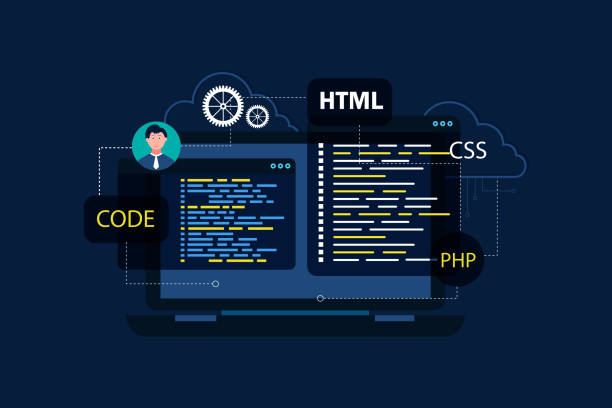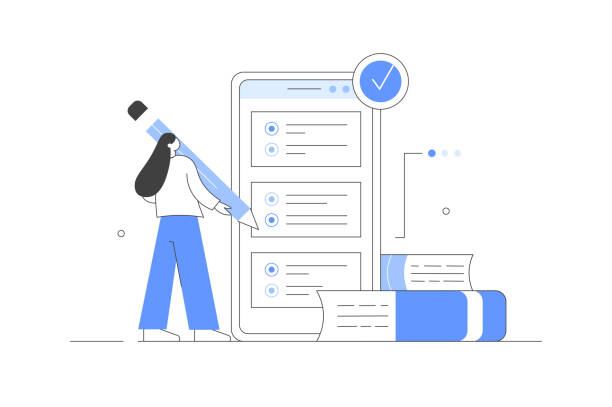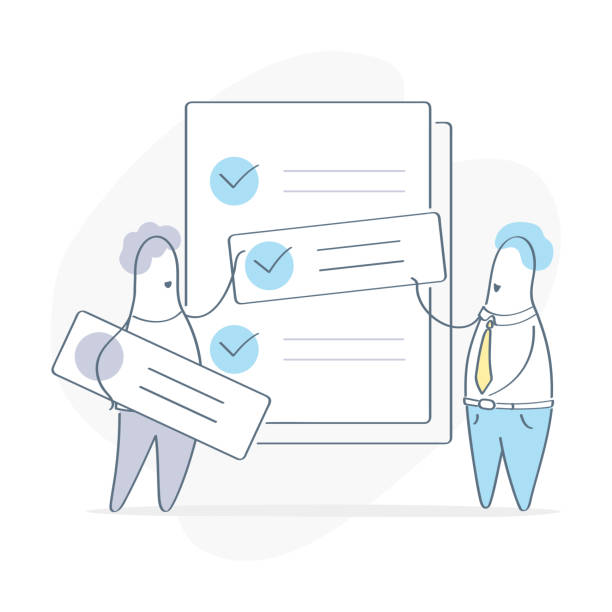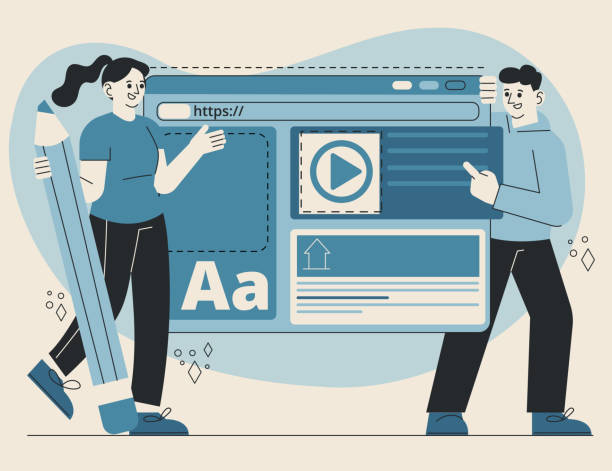Introduction to the Importance of Secure Website Design in Today’s Digital World

In the current era, where our daily lives and businesses are deeply intertwined with the online space, secure website design is no longer an option, but an undeniable necessity.
Websites, as the digital storefront of any organization or individual, host sensitive information ranging from users’ personal data to financial information and trade secrets.
Without adhering to #cybersecurity principles, this information is exposed to serious #cyberattacks, which can lead to #data_loss, damage to reputation, huge financial losses, and loss of #user_trust.
A successful attack can not only compromise data but may also disrupt website operations and even completely halt the business.
Therefore, from the very initial stages of conceptualization and development, the approach to secure website design must be central.
This is a continuous process that requires constant updates, active monitoring, and rapid response to new threats.
Neglecting this crucial aspect can result in extremely heavy costs, the recovery of which is sometimes impossible.
Cybersecurity on your website is the foundation of user trust and the survival of your business in the digital space.
Are you losing business opportunities because of an outdated website? With Rasawweb, solve the problem of not attracting potential customers through your website forever!
✅ Attract more high-quality leads
✅ Increase brand credibility in the eyes of customers
⚡ Get free corporate website design consultation
Common Web Security Threats and How to Identify Them

To have a secure and effective website design, it is essential to be familiar with the most common web security threats.
Understanding these threats helps us take appropriate preventive measures.
One of the most prevalent attacks is SQL Injection, where an attacker injects malicious SQL code into website inputs to gain access to or modify the database.
Cross-Site Scripting (XSS) attacks are also very common; in this type of attack, malicious JavaScript code is executed in the victim’s browser, which can lead to the theft of cookies or session information.
Distributed Denial of Service (DDoS) attacks, aiming to disable the server and website by sending a huge volume of traffic, result in real users being unable to access.
Furthermore, weaknesses such as outdated software, incorrect server configurations, and the use of weak passwords are gateways for attackers.
Secure website design involves a detailed analysis of these threats and the development of defensive strategies for each.
Vulnerability scanning tools and penetration testing can help identify weaknesses before they are discovered by attackers.
Principles of Secure Coding and Vulnerability Prevention

One of the main pillars in secure website design is adhering to secure coding principles.
Programming codes, whether on the server-side or client-side, must be written in a way that is resistant to common attacks.
User inputs should always be validated and filtered to prevent the injection of malicious code.
For example, using Prepared Statements or ORM (Object-Relational Mapping) when interacting with the database is an effective solution for preventing SQL Injection attacks.
Also, ensuring secure outputs (Output Encoding) is vital to prevent XSS attacks.
Developers should always use up-to-date security functions and libraries and leverage the built-in security features of frameworks and programming languages.
Proper error handling is also highly important; displaying generic error messages to users instead of technical details that could provide valuable information to attackers is a crucial principle.
Furthermore, removing unused code or sensitive comments in the final product helps reduce the attack surface.
Secure website design requires a proactive approach throughout all stages of the Software Development Life Cycle (SDLC) that includes continuous developer training and code review by security specialists.
The table below shows some common vulnerabilities and methods for preventing them:
| Vulnerability | Description | Prevention Methods |
|---|---|---|
| SQL Injection | Injecting malicious SQL code into inputs | Using Prepared Statements, input validation |
| XSS (Cross-Site Scripting) | Injecting malicious scripts into web pages | Secure outputs (Output Encoding), input validation |
| CSRF (Cross-Site Request Forgery) | Executing unwanted commands in the user’s browser | Using Anti-CSRF tokens |
| Insecure Direct Object References | Direct access to objects without access control | Implementing server-side access control |
The Role of SSL/TLS Certificates in Enhancing Website Security

One of the first steps in achieving secure website design is implementing SSL/TLS certificates.
These certificates play a vital role in encrypting communications between the user’s browser and the website server.
When a website uses HTTPS (the secure version of HTTP), all exchanged data, including login information, payment details, and personal data, are encrypted.
This encryption prevents attackers from eavesdropping on or tampering with information during transmission.
Without SSL/TLS, information is sent in plain text, which is easily intercepted and misused.
In addition to security, using HTTPS has other benefits: browsers typically mark websites without SSL as insecure, which can harm user trust and the website’s search engine ranking.
Correct installation and configuration of an SSL/TLS certificate is not only a fundamental security measure but also an important factor for improving SEO and attracting visitor trust.
In fact, any website that collects or processes information, or even simply for maintaining its credibility, should use SSL/TLS.
Secure website design would be incomplete without this initial protective layer.
Ensuring that the certificate is valid and up-to-date and uses strong encryption algorithms is very important.
Dissatisfied with your e-commerce website’s low sales?
Rasawweb is your solution for a professional and high-selling e-commerce site.
✅ Significant increase in sales and revenue
✅ Easy and enjoyable shopping experience for customers
⚡ Get a free consultation from Rasawweb now!
Robust Authentication and Authorization Solutions

In any secure website design, Authentication and Authorization mechanisms are of paramount importance.
Authentication refers to the process of verifying a user’s identity, while Authorization determines which resources an authenticated user has access to.
Using strong and complex passwords that combine uppercase and lowercase letters, numbers, and symbols is a fundamental step.
However, relying solely on passwords is not enough.
Implementing Multi-Factor Authentication (MFA), such as sending a code to the user’s mobile phone or using authentication apps, provides a powerful security layer.
This method limits attacker access even if the password is compromised.
In the authorization section, the Principle of Least Privilege should be followed; meaning that each user or system should only have access to the resources necessary to perform their tasks.
Implementing Role-Based Access Control (RBAC) helps organize and manage permissions precisely.
Furthermore, logging and monitoring all user login/logout activities and unsuccessful authentication attempts is essential for identifying suspicious patterns and Brute-Force attacks.
Secure website design requires strong policies for user account management and periodic review of access permissions.
The Importance of Periodic Security Audits and Penetration Testing

Even after an initial secure website design, cyber threats are constantly changing and evolving.
For this reason, conducting periodic Security Audits and Penetration Testing is of vital importance.
Security audits comprehensively examine security policies, processes, and systems to identify weaknesses and non-compliance with security standards.
These audits can be performed internally or by external specialist companies.
On the other hand, penetration testing simulates a real cyberattack on the website, performed by Ethical Hackers.
The goal of this test is to find vulnerabilities that may have been overlooked during the development process, such as weaknesses in coding, incorrect server configurations, or flaws in business logic.
The results of penetration testing provide a comprehensive report of discovered vulnerabilities, their severity, and corrective solutions.
Performing these activities regularly allows you to identify and address weaknesses before real attackers exploit them.
Secure website design is not a static process; rather, it requires continuous improvement and adaptation to the threat landscape.
Investing in these periodic inspections is an investment in maintaining the health and sustainability of your business.
Data Protection and User Privacy Compliance

In the modern world, secure website design means deep attention to user data protection and full compliance with their privacy.
With the advent of strict regulations like GDPR in Europe or CCPA in California, websites are obliged to have a transparent approach to the collection, storage, processing, and deletion of personal data.
These regulations define specific rights for users regarding their data, including the right to access, rectify, and erase data.
To achieve secure website design in this area, one must adhere to the principles of “Privacy by Design”; meaning that privacy considerations must be taken into account from the very initial stages of system design, rather than being added as a secondary feature at the end.
Data encryption, both in transit and at rest, is of high importance.
Also, clear Data Retention Policies should be defined so that personal data is deleted after it is no longer needed.
Employee training on the importance of privacy and data protection protocols is also vital.
Data breaches can lead to heavy fines and a severe loss of user trust.
Adhering to these principles is not only legally necessary but also demonstrates your commitment to users and creates a safer online environment.
| Principle | Description | Practical Actions in Website Design |
|---|---|---|
| Informed Consent | Obtaining explicit and informed user consent for data collection | Cookie banner, transparent consent forms |
| Data Minimization | Collecting only necessary data for a specific purpose | Concise registration forms, not requesting unnecessary information |
| Transparency | Clear communication about how data is used | Comprehensive and understandable privacy policy |
| Security | Protecting data against unauthorized access or breach | Encryption, access control, regular backups |
Securing the Server and Web Hosting Infrastructure

Secure website design is not limited to coding; it also includes securing the infrastructure on which the website is hosted.
Web servers, databases, and operating systems are all potential entry points for attackers.
One of the most important measures is the regular updating of all server software, operating systems, libraries, and frameworks.
Security Patches are vital for addressing discovered vulnerabilities.
Correct server configuration is also highly important; unnecessary services and ports should be disabled, and insecure default settings avoided.
Implementing a strong Firewall is essential for controlling inbound and outbound traffic and blocking unauthorized access.
Additionally, using Intrusion Detection Systems (IDS) and Intrusion Prevention Systems (IPS) can help identify and block attacks in real-time.
Server access management should also be done carefully; using strong passwords for SSH access, disabling Root Login, and using SSH keys instead of passwords significantly increases security.
Regular backups of all server data and settings, and testing the restorability of these backups, is an important proactive measure to combat data loss in the event of a successful attack.
This comprehensive approach to secure website design ensures the protection of the website across various layers.
Are you losing business opportunities because of an outdated website? With Rasawweb, solve the problem of not attracting potential customers through your website forever!
✅ Attract more high-quality leads
✅ Increase brand credibility in the eyes of customers
⚡ Get free corporate website design consultation
User Awareness and Education: Key to Comprehensive Security

Secure website design is not limited to technical measures; the biggest weakness in the security chain is often the human factor.
Educating and raising awareness among users, both internal website staff and end-users, is a vital component of a comprehensive security strategy.
Users should be aware of common threats such as phishing, social engineering attacks, and the importance of using strong and unique passwords.
They should know how to identify suspicious URLs, avoid opening unwanted email attachments, and only enter their personal information on secure and reputable websites.
For internal staff, training on company security policies, managing sensitive information, and reporting suspicious activities is essential.
Additionally, they should be familiar with the importance of updating their software, using antivirus and personal firewalls, and locking their screens when leaving their systems.
Creating a strong security culture where everyone understands and takes their responsibility for security seriously can significantly reduce the risk of successful attacks.
Publishing up-to-date security information and safety recommendations through a blog or FAQ section on the website can also help raise awareness among end-users.
Ultimately, the success of a secure website design depends on the participation and awareness of all stakeholders.
The Future of Secure Website Design and Upcoming Challenges

With the continuous advancement of technology and the emergence of new threats, secure website design is a dynamic and evolving field.
The future of web security will be accompanied by new challenges and opportunities that require innovative approaches.
One of the most important upcoming trends is the use of Artificial Intelligence (AI) and Machine Learning (ML) in attack detection and prevention.
These technologies can identify suspicious traffic patterns with higher accuracy and automatically respond to threats.
The emergence of Web 3.0, blockchain, and decentralized technologies also poses new security challenges that require security solutions tailored to these architectures.
Threats related to the Internet of Things (IoT) and software supply chain attacks are also increasing, requiring a more comprehensive view of security beyond the website itself.
Another challenge is the shortage of cybersecurity specialists and the urgent need to train skilled personnel in this field.
Furthermore, the increasing complexity of phishing and social engineering attacks doubles the necessity for continuous user education and awareness.
To maintain secure website design in the future, organizations and developers must always be one step ahead of attackers, adopt a proactive approach, and invest in new security technologies.
International cooperation and information exchange regarding threats will also be essential for creating a safer cyberspace.
Frequently Asked Questions
| No. | Question | Answer |
|---|---|---|
| 1 | What does secure website design mean? | Secure website design refers to a set of measures and methods used to protect a website against cyberattacks, unauthorized access, data leaks, and other security threats. Its goal is to maintain the confidentiality, integrity, and availability of information. |
| 2 | Why is website security important? | Website security is crucial for maintaining user trust, protecting sensitive information (such as personal and financial data), preventing financial losses, preserving brand reputation, and complying with legal regulations (such as GDPR). A security breach can lead to customer loss and heavy fines. |
| 3 | What are some of the most common security attacks against websites? | Common attacks include SQL Injection, XSS (Cross-Site Scripting), CSRF (Cross-Site Request Forgery), Brute Force attacks, DDoS attacks, Broken Authentication, and Missing Function Level Access Control. |
| 4 | What is the role of an SSL/TLS certificate in website security? | An SSL/TLS certificate (which leads to an HTTPS address) is used to encrypt data exchanged between the user and the website server. This prevents eavesdropping on or tampering with sensitive information such as passwords and credit card details during transmission and verifies the website’s authenticity. |
| 5 | How can SQL Injection attacks be prevented? | To prevent SQL Injection, Prepared Statements or ORM (Object-Relational Mapping) with validated parameters should be used. Additionally, thorough filtering and validation of user inputs (Input Validation) and applying the principle of least privilege in the database are essential. |
| 6 | What is HTTP Strict Transport Security (HSTS) and how does it help security? | HSTS is a web security policy that tells browsers to load the website only over an HTTPS connection, even if the user enters the address with HTTP. This prevents Downgrade attacks and cookie hijacking on public Wi-Fi networks. |
| 7 | What is the importance of regularly updating software and plugins for website security? | Regularly updating the Content Management System (CMS), plugins, themes, and other software components of the site is crucial to fix discovered security vulnerabilities. Developers constantly release security patches, and failing to update can leave the site vulnerable to known attacks. |
| 8 | What measures can be taken to increase the security of the website administration section (admin panel)? | Changing the default admin panel path, using strong passwords and two-factor authentication (2FA), restricting access to specific IPs, using CAPTCHA on login pages, monitoring logs, and continuously updating the CMS are among these measures. |
| 9 | Why is filtering and validating user inputs (Input Validation) important? | Filtering and validating inputs helps prevent the injection of malicious code or unauthorized data through forms, URLs, or other user input sections. This prevents attacks like XSS and SQL Injection, which exploit invalid inputs. |
| 10 | Name some common tools or services for checking and enhancing website security. | Tools such as Web Application Firewall (WAF), vulnerability scanners (e.g., Acunetix, Nessus), Intrusion Detection and Prevention Systems (IDS/IPS), CDN services with security features (e.g., Cloudflare), and periodic Penetration Testing can enhance website security. |
And other services of Rasawweb Advertising Agency in the field of advertising
Smart Customer Journey Map: A specialized service for increasing website traffic growth based on intelligent data analysis.
Smart Custom Software: A specialized service for increasing sales growth based on optimizing key pages.
Smart Social Media: A creative platform for improving customer acquisition with marketing automation.
Smart Advertising Campaign: A creative platform for improving campaign management using real data.
Smart Sales Automation: A creative platform for improving customer behavior analysis with precise audience targeting.
And over hundreds of other services in the field of internet advertising, advertising consultation, and organizational solutions
Internet Advertising | Advertising Strategy | Advertorials
Sources
Key Tips for Secure Website Design
Website Security Checklist
Principles of Secure Coding for the Web
Website Vulnerability Protection
? Rasawweb Afarin, your strategic partner in the digital world, brings your business to the peak of success by providing innovative marketing solutions and professional e-commerce website design. For free consultation and to learn more about our services, contact us now. The bright future of your business begins with Rasawweb Afarin.
📍 Tehran, Mirdamad Street, next to Bank Markazi, Southern Kazeroon Alley, Ramin Alley, No. 6



